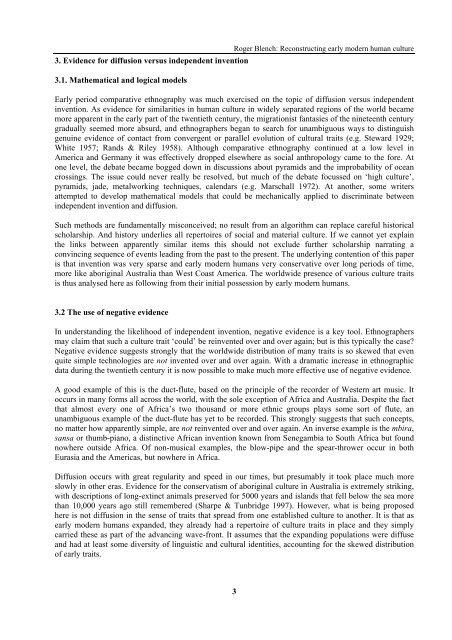using ethnography to reconstruct the culture of early ... - Roger Blench
using ethnography to reconstruct the culture of early ... - Roger Blench
using ethnography to reconstruct the culture of early ... - Roger Blench
You also want an ePaper? Increase the reach of your titles
YUMPU automatically turns print PDFs into web optimized ePapers that Google loves.
3. Evidence for diffusion versus independent invention<br />
3.1. Ma<strong>the</strong>matical and logical models<br />
<strong>Roger</strong> <strong>Blench</strong>: Reconstructing <strong>early</strong> modern human <strong>culture</strong><br />
Early period comparative <strong>ethnography</strong> was much exercised on <strong>the</strong> <strong>to</strong>pic <strong>of</strong> diffusion versus independent<br />
invention. As evidence for similarities in human <strong>culture</strong> in widely separated regions <strong>of</strong> <strong>the</strong> world became<br />
more apparent in <strong>the</strong> <strong>early</strong> part <strong>of</strong> <strong>the</strong> twentieth century, <strong>the</strong> migrationist fantasies <strong>of</strong> <strong>the</strong> nineteenth century<br />
gradually seemed more absurd, and ethnographers began <strong>to</strong> search for unambiguous ways <strong>to</strong> distinguish<br />
genuine evidence <strong>of</strong> contact from convergent or parallel evolution <strong>of</strong> cultural traits (e.g. Steward 1929;<br />
White 1957; Rands & Riley 1958). Although comparative <strong>ethnography</strong> continued at a low level in<br />
America and Germany it was effectively dropped elsewhere as social anthropology came <strong>to</strong> <strong>the</strong> fore. At<br />
one level, <strong>the</strong> debate became bogged down in discussions about pyramids and <strong>the</strong> improbability <strong>of</strong> ocean<br />
crossings. The issue could never really be resolved, but much <strong>of</strong> <strong>the</strong> debate focussed on ‘high <strong>culture</strong>’,<br />
pyramids, jade, metalworking techniques, calendars (e.g. Marschall 1972). At ano<strong>the</strong>r, some writers<br />
attempted <strong>to</strong> develop ma<strong>the</strong>matical models that could be mechanically applied <strong>to</strong> discriminate between<br />
independent invention and diffusion.<br />
Such methods are fundamentally misconceived; no result from an algorithm can replace careful his<strong>to</strong>rical<br />
scholarship. And his<strong>to</strong>ry underlies all reper<strong>to</strong>ires <strong>of</strong> social and material <strong>culture</strong>. If we cannot yet explain<br />
<strong>the</strong> links between apparently similar items this should not exclude fur<strong>the</strong>r scholarship narrating a<br />
convincing sequence <strong>of</strong> events leading from <strong>the</strong> past <strong>to</strong> <strong>the</strong> present. The underlying contention <strong>of</strong> this paper<br />
is that invention was very sparse and <strong>early</strong> modern humans very conservative over long periods <strong>of</strong> time,<br />
more like aboriginal Australia than West Coast America. The worldwide presence <strong>of</strong> various <strong>culture</strong> traits<br />
is thus analysed here as following from <strong>the</strong>ir initial possession by <strong>early</strong> modern humans.<br />
3.2 The use <strong>of</strong> negative evidence<br />
In understanding <strong>the</strong> likelihood <strong>of</strong> independent invention, negative evidence is a key <strong>to</strong>ol. Ethnographers<br />
may claim that such a <strong>culture</strong> trait ‘could’ be reinvented over and over again; but is this typically <strong>the</strong> case?<br />
Negative evidence suggests strongly that <strong>the</strong> worldwide distribution <strong>of</strong> many traits is so skewed that even<br />
quite simple technologies are not invented over and over again. With a dramatic increase in ethnographic<br />
data during <strong>the</strong> twentieth century it is now possible <strong>to</strong> make much more effective use <strong>of</strong> negative evidence.<br />
A good example <strong>of</strong> this is <strong>the</strong> duct-flute, based on <strong>the</strong> principle <strong>of</strong> <strong>the</strong> recorder <strong>of</strong> Western art music. It<br />
occurs in many forms all across <strong>the</strong> world, with <strong>the</strong> sole exception <strong>of</strong> Africa and Australia. Despite <strong>the</strong> fact<br />
that almost every one <strong>of</strong> Africa’s two thousand or more ethnic groups plays some sort <strong>of</strong> flute, an<br />
unambiguous example <strong>of</strong> <strong>the</strong> duct-flute has yet <strong>to</strong> be recorded. This strongly suggests that such concepts,<br />
no matter how apparently simple, are not reinvented over and over again. An inverse example is <strong>the</strong> mbira,<br />
sansa or thumb-piano, a distinctive African invention known from Senegambia <strong>to</strong> South Africa but found<br />
nowhere outside Africa. Of non-musical examples, <strong>the</strong> blow-pipe and <strong>the</strong> spear-thrower occur in both<br />
Eurasia and <strong>the</strong> Americas, but nowhere in Africa.<br />
Diffusion occurs with great regularity and speed in our times, but presumably it <strong>to</strong>ok place much more<br />
slowly in o<strong>the</strong>r eras. Evidence for <strong>the</strong> conservatism <strong>of</strong> aboriginal <strong>culture</strong> in Australia is extremely striking,<br />
with descriptions <strong>of</strong> long-extinct animals preserved for 5000 years and islands that fell below <strong>the</strong> sea more<br />
than 10,000 years ago still remembered (Sharpe & Tunbridge 1997). However, what is being proposed<br />
here is not diffusion in <strong>the</strong> sense <strong>of</strong> traits that spread from one established <strong>culture</strong> <strong>to</strong> ano<strong>the</strong>r. It is that as<br />
<strong>early</strong> modern humans expanded, <strong>the</strong>y already had a reper<strong>to</strong>ire <strong>of</strong> <strong>culture</strong> traits in place and <strong>the</strong>y simply<br />
carried <strong>the</strong>se as part <strong>of</strong> <strong>the</strong> advancing wave-front. It assumes that <strong>the</strong> expanding populations were diffuse<br />
and had at least some diversity <strong>of</strong> linguistic and cultural identities, accounting for <strong>the</strong> skewed distribution<br />
<strong>of</strong> <strong>early</strong> traits.<br />
3

















